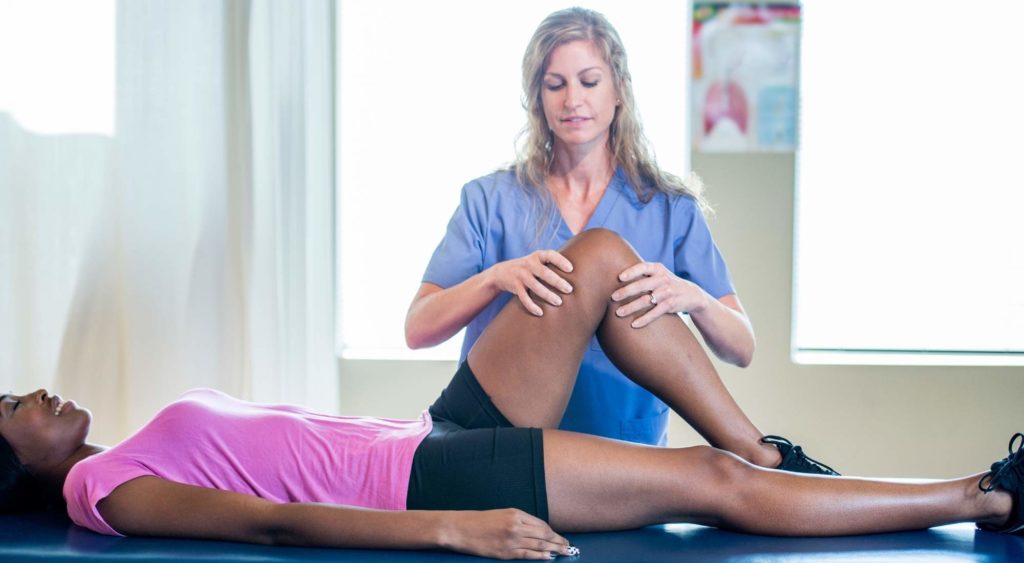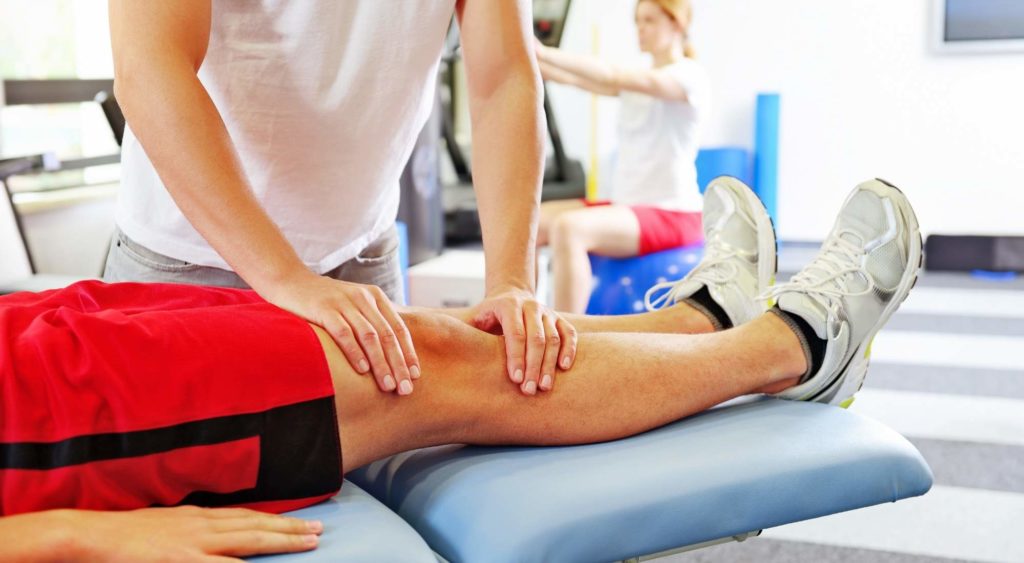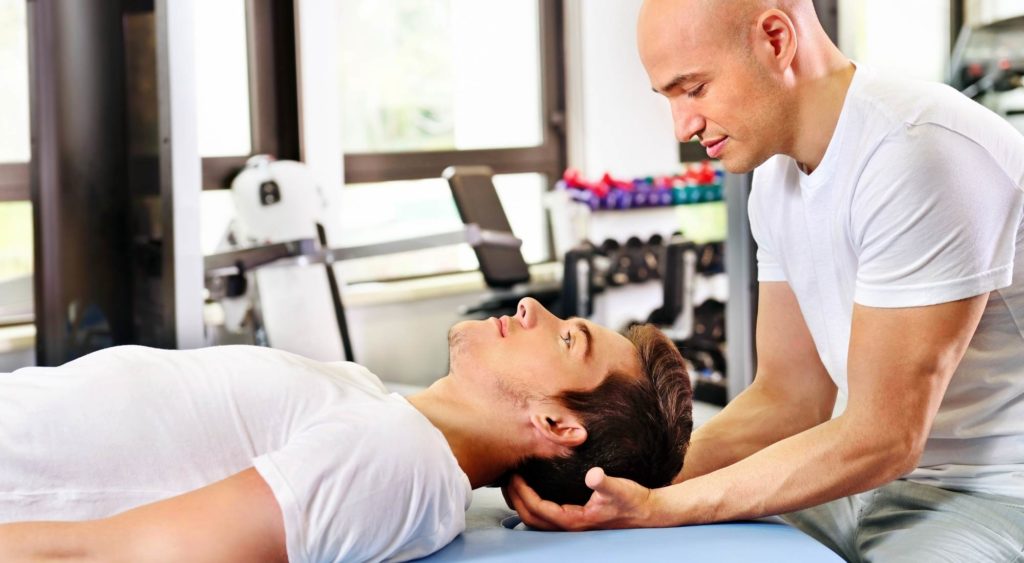
You’re on your third week of Couch to 5K and woke up this morning to a searing pain in your left calf.
Or maybe you suffered a recent fall, and it hurts to walk.
You’ve heard about physical therapy massage and are wondering if it might be able to help you find relief.
This guide shares three major benefits of adding physical therapy massage to your physical therapy care to help increase comfort and healing.
Table of Contents
- What Is Massage Therapy?
- Spa Massage vs. Physical Therapy Massage
- Spa Massage
- Physical Therapy Massage
- Physical Therapy And Massage: How Do They Work Together To Benefit You?
- Do Physical Therapists Do Massage?
- Active Release Therapy
- Trigger Point Release Therapy
- Soft Tissue Massage
- Myofascial Release
- 3 Benefits Of Receiving Massage In Physical Therapy
- #1 Improve Flexibility and Range of Motion
- #2 Improve Posture
- #3 Lessen Scar Tissue
- Is Massage Therapy Better Than Physical Therapy?
- Voted #1 for Physical Therapists: Learn How In Motion O.C. Uses the Latest in Physical Therapy to Meet Your Rehabilitation Needs

What Is Massage Therapy?
Massage therapy is a form of bodywork designed to:
- Increase circulation
- Improve quality of sleep
- Relax and lengthens muscles
- Release endorphins
- Enhance circulation
- Boost mental alertness
- Stimulate the movement of lymphatic fluid
- Improve immune function
- Reduce anxiety and stress
Spa Massage vs. Physical Therapy Massage
If you’re thinking all massage therapy is created equal, think again.
Physical therapy massage and spa massage are distinctly different with each having its own unique purposes in the realm of massage therapy,
Spa Massage
Spa massage is generally done in a very peaceful setting
It may include:
- A heated massage table
- Soft music
- Essential oils
- Warm blankets
Spa massage therapists utilize a variety of techniques to manipulate the soft tissues of your body, including your:
- Muscles
- Ligaments
- Connective tissues
- Tendons
- Skin
The goal of spa massage is to de-stress and relax the patient and provide relief for painful areas.
Spa massage can be ongoing, with some massage therapists working with a patient for many years.
Physical Therapy Massage
If you walk into your physical therapy massage appointment expecting to have a spa massage, you’re going to be sorely disappointed.
Physical therapy massage is done in a clinical-type setting and involves highly individualized treatment, with the goal of restoring overall function by:
- Improving flexibility and range of motion
- Improving posture
- Decreasing scar tissue
During a physical therapy massage, the therapist is usually zeroed in on fixing a particular problem, in a specific area of the body.
They want to get the athlete back on the field or to help their patient walk without the assistance of a walker.
Physical therapists typically work short-term with a patient.
Their goal is to get the patient better, so they can move on with life.
Physical therapists doing massage are trained in targeted techniques and must keep up-to-date with continuing education courses and certifications.
Physical Therapy And Massage: How Do They Work Together To Benefit You?
Physical therapists specialize in the way your body moves.
They are trained to recognize any distorted postural patterns or habits, such as…
- Forward head posture a.k.a. “Tech/text Neck”
- Rounded shoulder posture
- Swayback
- Flatback; or
- Kyphosis
… that could possibly lead to injury.
Their specialty is knowing how to keep your musculoskeletal system healthy.

Do Physical Therapists Do Massage?
Yes — Physical therapists perform a variety of massage techniques including:
- Active Release therapy
- Trigger point release
- Soft tissue massage
- Myofascial release
Active Release Therapy
Active Release Therapy, also known as ART, combines manipulation and movement to treat your body’s soft tissue, including your…
- Muscles
- Tendons
- Fascia; and
- Nerves.
ART is more targeted than traditional massage, with each individual muscle being taken through the full range of motion.
ART Is particularly beneficial in the treatment of specific injuries including:
- Repetitive Strains
- Adhesions
- Tissue hypoxia
- Joint dysfunction
- Carpal tunnel syndrome
- Tension headaches
- Sciatic nerve pain
- Plantar Fasciitis
- Shin splints
- Tennis elbow
Trigger Point Release Therapy
As the name suggests, trigger point therapy targets specific “trigger points” throughout the body.
That muscle-knot in your neck…you guessed it… trigger point.
The goal of trigger point therapy is to eliminate the trigger points.
Sounds fairly straightforward, right?
But here’s the tricky part:
Trigger points, in most cases, actually cause pain in a different part of your body.
For example, you may have a headache or neck pain that is actually being caused by a trigger point that is located on your back.
Trigger point therapy is very effective — Unfortunately, though, it’s not very relaxing.
When doing trigger point therapy, the therapist will apply specific indirect pressure onto the trigger point with their thumb or a tool until the knot relaxes.
Trigger point therapy is particularly good for neck and shoulder pain.
Soft Tissue Massage
If you’re thinking that soft tissue massage is a gentle technique, think again.
“Soft” in this case, is referring to soft tissues such as:
- All levels of muscle
- Tendons
- Skin
- League
- Special
- Nerves
- Fibrous tissue
- Blood vessels
Soft tissue massage works a wide range of depths, durations, and pressures and is used to restore normal flexibility to muscle.
It’s especially useful on a muscle that has become shortened and tight and is known for providing relief to those suffering from:
- Headaches
- Poor posture including slouching
- Plantar fasciitis
- Prolonged sitting
- Facial tension
- Stiff neck
- Arthritis
- Rehabilitation following surgery
- Tennis elbow
- Low back pain
- Upper back and shoulder pain
Soft tissue massage is generally used after the muscle has been “warmed up” by a lighter massage technique.
Soft tissue massage is known to:
- Increase circulation
- Decrease pain
- Increase muscle flexibility
- Decrease muscle spasms
- Improve overall mobility
Myofascial Release
Myofascial Release, or Myo, is a form of physical therapy that is often used to treat myofascial pain syndrome.
This technique works the tough, thin, elastic connective tissues surrounding the muscles.
The goal is to…
- Relax
- Lengthen; and
- Realign
… the tightened fascia.
When applying myofascial massage, the therapist uses slow, sustained pressure on the muscle.
Incorporated with a stretching technique, this combination loosens the tight, stiff areas.
The goal of myofascial release is to relieve pain and give you back your full range of motion.

3 Benefits Of Receiving Massage In Physical Therapy
Being able to move your body properly is essential for your overall comfort and quality of life.
Whether you are…
- Recovering from an injury
- Hoping to reduce inflammation and pain; or
- Just needing to work a few unused muscle groups
… physical therapy massage can help.
Let’s take a look at 3 benefits of massage in physical therapy.
#1 Improve Flexibility and Range of Motion
Do some parts of you not move quite like they used to?
Maybe you have difficulty reaching over or bending down.
Would you like to increase your flexibility for athletic activities?
Physical therapy massage can help improve your flexibility and range of motion.
Range of motion is determined by how far you can move a joint in a variety of directions.
Flexibility refers to the ability of your soft tissues, such as your…
- Muscles
- Tendons, and
- Connective tissues
… to lengthen through each joint’s available range of motion.
The two go hand-in-hand, with your range of motion being affected by your flexibility.
Physical therapy massage boosts your flexibility and range of motion by stretching the muscle fibers that attach to your bones by targeting and working specific muscle groups that may feel painful or extra tight.
Physical therapy massage will help you slowly increase your flexibility, so you can safely enjoy the activities you love.
#2 Improve Posture
Take a quick posture inventory next time you’re working on your computer or your phone.
Chances are, you’re slouching, with your:
- Shoulders rolled in
- Neck extended
- Head tipped forward
It is probably safe to guess that you are also suffering from a headache, or neck and shoulder pain.
Let’s face it: We all need to improve our posture in some way or another.
Physical therapy massage helps to relax your overworked muscles that are the result of having poor posture.
Your body can then relax back into its natural alignment.
Giving your body the ability to fall back into healthy and natural movements can be one of the best aspects of physical therapy and massage.
#3 Lessen Scar Tissue
Scar tissue can have a huge effect on your:
- Flexibility
- Range of motion
- Muscle development
Since it is tough and inflexible, scar tissue can limit the flexibility and range of motion of the entire muscle it’s attached to.
But great news.
Studies reveal that physical therapy massage can be beneficial in lessening scar tissue.
Physical therapy massage techniques, such as Myofascial release, are a great way to break up scar tissue in the soft tissue just beneath your skin, thus:
- Improving the soft tissue function
- Reducing pain at the side of your scar
- Increasing your joint’s range of motion
Is Massage Therapy Better Than Physical Therapy?
No — Physical therapy and massage therapy are equally beneficial, depending upon the condition being treated.
If you’re recovering from injury or need to restore function in your body, physical therapy will serve you best.
But, if you’re hoping to relax and relieve sore muscles, you’ll want to choose massage therapy.
Voted #1 for Physical Therapists: Learn How In Motion O.C. Uses the Latest in Physical Therapy to Meet Your Rehabilitation Needs
At In Motion O.C., we offer a wide range of massage therapies, including
- Physical therapy
- Deep Tissue
- Swedish
- Stretching
Get in touch with us today to start your road to recovery.



